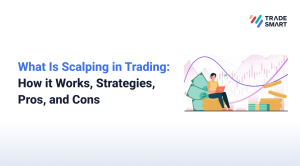
It is common knowledge that the goal of investing in financial markets is to increase wealth over time. While traditional investing approaches focus on long-term strategies aimed at capital appreciation, scalp trading has become a popular strategy among investors who want faster profits.
Investors are drawn to this rapid-fire strategy because it produces quick gains by taking advantage of minor price differentials several times a day. For traders who are decisive and prefer the fast-paced nature of the market’s volatility, scalping would be a suitable approach. This article will give you an overview of the scalp trading strategy, its potential benefits, and the challenges involved. We will also see how scalp trading differs from day trading.
What Is Scalp Trading?
Scalping trading or scalping is a trading strategy that investors often use to make profits off of small changes in the financial market prices. Rather than making long-term investments, investors who practise scalp trading benefit quickly from a large number of shorter trades, which frequently last only a few seconds or minutes.
Unlike the traditional long-term investment route that is more publicly known, this fast-paced approach allows traders to execute numerous trades throughout the day to capitalise on small price differentials. After all, the primary goal of scalping is to accumulate profits rapidly by leveraging small price fluctuations.
How Does Scalp Trading Work?
With scalping, traders appear to believe the notion that most stocks in the stock market have a predictable initial price movement. What happens after the initial movement, however, becomes harder to predict. In contrast to traders who concentrate on optimising rewards from huge winning trades, scalpers seek to generate several modest profits rather than waiting for larger gains.
Scalping trading focuses on making lots of quick trades to capture small profits from small price movements. This strategy is about making many small wins that outweigh the losses which helps traders stay profitable in the long run.
Scalpers follow a set of concepts or principles when practicing scalp trading. Three key concepts are as follows:
- Reducing exposure lowers risks: By minimising your exposure to the trading market, you reduce your chances of encountering unexpected events that could potentially harm your investments.
- Small price changes are easier to achieve: The stock price needs to rise dramatically in order to provide a larger profit, and a stronger supply and demand mismatch is also necessary. Smaller price movements, on the other hand, are easier to catch and scalpers focus on these smaller moves because of it.
- Frequent small price movements: Large fluctuations are not always seen in stocks. They may move repeatedly over the day but only in small amounts. Scalpers use these frequent little shifts to their advantage by making rapid trades and profiting from them. It’s similar to capturing several tiny fish as opposed to holding out for a single large catch.
However, it is important to note that the scalping trading strategy requires a high level of precision, discipline, and the ability to react quickly to market movements.
Scalping Trading vs Day Trading
As we now know, scalp trading is a trading strategy that investors would often use to make quick profits by taking advantage of the minute price changes (say 5 seconds or so) in the market. Day trading, on the other hand, is a strategy that goes on for at least a few hours but ends within a single trading day.
Here are a few ways on how you can distinguish between the two:
|
Scalping Trading |
Day Trading |
| Focuses on achieving small but frequent gains by targeting small price movements. | Focuses on achieving larger profits by targeting comparatively larger price movements. |
| The trade takes place within a few seconds or a minute. | The trade lasts for a few hours, preferably ending within a single trading day or session. |
| Scalpers may execute numerous trades in a single trading day. | Day traders execute fewer trades in a single session. |
| In order to limit losses, scalpers often implement strict risk management rules. | Day traders too, implement risk management rules but they may have slightly more flexibility. |
Advantages of Scalp Trading
Quick Profits
By capitalising on small price movements, scalping trading increases the potential of making quick profits. This means that even the smallest price changes can result in profits for scalpers, especially when executed efficiently and frequently.
Reduced Exposure to Market Risks
Because their trade strategy minimises their exposure to the volatility of the trading market, they reduce their risks of loss.
Flexibility and Adaptability
There is a certain level of flexibility in scalping trading in terms of trading frequency, timeframes, and market conditions. Scalpers are able to adapt their strategies to suit different market environments, such as trending markets, or high volatility periods. This adaptability allows scalpers to capitalise on various opportunities and optimise their performance in different market conditions.
Enhanced Discipline and Focus
Due to the fast-paced nature of scalp trading, scalpers are required to have intense discipline and focus. They must be able to make quick decisions, and manage risk effectively to succeed in highly competitive trading environments. This disciplined approach aids in improving their trading skills, decision-making abilities, and emotional control, which are beneficial traits when aiming for long-term success in trading.
Challenges of Scalp Trading
Time-Consuming
Due to the fast-paced nature of the strategy, constant market monitoring is required which can be time-consuming and demanding on the traders. In order to capitalise on scalping trading, scalpers have to be willing to devote much of their time to the trade. This, however, might not be practical for traders who have other commitments outside of trading.
Limited Profit Potential
Because scalp trading typically targets small price movements in the market, it often results in a limited profit potential per trade. What this means is that since the goal of scalping trading is to catch these small price movements, the potential profits from each trade are also small.
Increased Stress
The fast-paced world of trading, scalping in particular, can induce stress and emotional pressure which can lead to biases in decision-making and impulsive trading behaviour.
Stress can have an impact on an individual’s emotional control which could potentially impair their judgement and result in losses. Therefore, it is crucial that scalpers have discipline and good control over their emotions.
To summarise, the disadvantages of scalping trading include its time-consuming nature, increased stress and emotional pressure, and limited profit potential amongst others.
Types of Scalping Trading Strategies
Scalping strategies come in various forms, each with its own approach to capture quick profits from small price movements.
Breakout Trading
The breakout trading method is popularly used by scalpers. It involves identifying breakouts and timing their trade entry to coincide with a breakout, and riding the market rise until the first exit signal appears. With the use of stop-loss orders, breakout traders are able to limit their potential losses in case a breakout trade fails and the market price reverts.
Range Trading
With range trading, traders seek to make profits when the security of an asset’s price moves within an established range. Range traders often prefer markets with well-defined and stable price fluctuations. In order to execute winning trades inside the range, a range trader requires patience, discipline, and the ability to accurately recognise levels of support and resistance.
Momentum Trading
Momentum trading is a strategy where traders aim to profit from the continuation of an existing trend in the financial markets. They capitalise on the assumption that the momentum of a price movement that has been moving in a certain direction is likely to continue moving in that direction for a certain period of time.
Momentum trading requires a deep understanding of technical analysis, trend identification, and risk management principles in order to be able to effectively implement it in various financial markets including stocks, currencies, and cryptocurrencies.
Tools and Indicators Used for Scalping Trading
In order to make quick and informed decisions in the fast-paced world of scalp trading, scalpers make use of various tools and indicators available to them. Let us take a look at a few of them.
- Candlestick charts: Traders use candlestick charts to help visualise price movements over a specific period of time.
- Level II Quotes: Level II quotes provide traders with real-time access to market depth, showing the current bid and ask prices, as well as the order sizes at each price level. Access to this information helps scalp traders determine the supply and demand dynamics.
- Tick Charts: Tick charts show price movements based on the number of trades executed, rather than time intervals. Scalp traders prefer tick charts for their ability to filter out low-volume periods and focus on periods of high trading activity, providing a clearer picture of market dynamics.
- Moving Averages: By averaging price data over an established time frame, moving averages assist scalpers in spotting patterns and possible entry and exit locations. Scalper traders frequently utilise short-term moving averages, such as the 5- or 10-period moving average, to pinpoint short-term price momentum.
Conclusion
With its focus on rapid trades and leveraging short-term opportunities, scalp trading can be an attractive option for traders who thrive in fast-paced environments and possess the discipline to execute precise and timely trades. That being said, it is important to remember that scalp trading can be time-consuming, requires intense discipline, and sound knowledge of entry and exit strategies.
TradeSmart understands the diverse needs of traders and strives to provide them with the tools and resources to navigate the world of trading. With access to advanced trading tools and real-time expert insights during market hours, TradeSmart empowers traders to make informed decisions. Start your trading journey today by opening a free Demat account!
FAQs
How is scalp trading different from traditional investing?
Unlike traditional investments that wait on long-term appreciation of capital, scalping trading aims to take advantage of the small price movements in the market in order to make quick profits.
How do scalpers manage risks in their trades?
Because of the fast-paced nature of the trading strategy and the volatility of the financial market, scalpers implement strategies such as stop-loss orders and position sizing in order to minimise their potential losses.
Is scalping trading suitable for a beginner?
Scalp trading not only requires discipline and focus but it is also dependent on experience in market prediction. Thus, scalp trading is not recommended for beginners. They are recommended to start with a strong and basic understanding of trading before moving to scalp trading.
How much time does a scalper spend trading each day?
As the strategy involves making numerous trades in a day in order to capitalise on small price movements, scalpers typically spend several hours actively trading. Scalp trading is a time-consuming activity that requires the individual’s full attention.
How is day trading different from scalp trading?
Although day trading and scalp trading are both short-term investments, day trading focuses on larger price movements and typically ends within a single trading day. Scalping trading focuses on small price movements that usually last for a few seconds or minutes.













